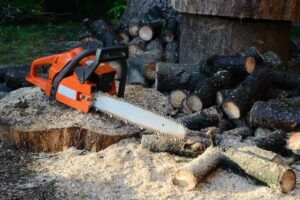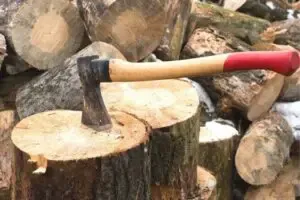
Overcoming the lean of a tree during felling is not an easy task. Depending on the direction the tree is leaning towards, it is often necessary to change the direction and timing of the falling the tree to avoid other objects.
While many techniques are available for making this change happen, not all will work for everybody.
There are those who rely on ropes to keep the tree under control by realigning its center of gravity, while others use different tools.
I have every so often watched individuals with no concept of felling risks, resistance, and tree mechanics spectacularly fail in changing the direction of the trees as they fall.
Sometimes, the rope works too, but not as regularly as a wedge. If you have heard of them or even used one, then you probably know how great they are at wedging the tree in any direction you desire.
However, using a wedge to tip a back-leaning tree trunk is not as straightforward as it may look.
Types And Sizes Of Wedges
There are three types of wedges in use today for those who want to make light work of their wood preparation work. These include felling wedges, bucking wedges, and splitting wedges.

Felling Wedges
These wedges are also known as winter wedges. They have angular points on them that allow for biting into the tree stump. When used for felling, these are placed in the back-cut to overcome the leaning forces of the tree. Thus, the lift created sends the tree being felled in the direction the user requires.
Since these wedges are placed in the same path of the chainsaw, they are made of soft material so that the chain cuts through it when they come into contact.
Hence, those manufactured from the wood fiber can be used, but most of the wedges are made from plastics with fillers.
Typically, these wedges are availed in lengths of 5.5, 8, 10, 12, 15, and 20 inches. However, the lengths are not restricted to these and maybe even longer.
Generally, the taper on these wedges is slow since a too fast slope would result in higher resistance to the hammer hit.
Taper designs on these type range from a single taper to a double and triple taper. First, a single taper has the tapering on only one side. The double taper slopes gradually on both sides. Lastly, the triple taper starts by being a single taper, then increases the taping angle about halfway.
Bucking Wedges
Also called summer wedges, these are designed to be soft on both of sides. This design feature makes them easy to remove from the kerf after use.
Since the compressional resistance requirement is not that critical, plastic and wooden wedges work just fine. The soft material also allows for pinching by the chainsaw during bucking.
Mostly, these wedges are used for getting out a stuck chainsaw out of the kerf. Insist on having a reinforced wedge so that it holds up well during the hammering.
Splitting Wedges
As the name insinuates, these wedges are used for splitting firewood or in the production of fencing and railing wood.
For this application, more impact resistance from the hammer and wood is required. Thus these are made from forgings or hardened steel to take the repeated blows.
Unlike the slow tape on the previous types, these particular ones feature a steep and heavy tape for quickly separating the wood. The shaping is not restricted to a wedge. Some of them are in a cone shape to quickly get the job done.
At no time should you substitute a splitting wedge for either bucking or felling wedge. Any contact between the chainsaw and the hardened wedge damages the chain and produces reactionary forces that increase the risk of injury for you and the bystanders.
Top Rated Felling Wedges – Quick Comparisons
Using Wedges To Fell Trees
The working principle of a wedge is a simple one. It supports the tree trunk/bole, hence preventing the saw from being bound into the compression zone.
Alternatively, it is used for changing the direction of a falling tree when being harvested.
For this application, the wedge acts as the fulcrum that lifts the center of the tree past its pivot point for it to fall into the opposite direction of lean.
1. Make The Face Notch
First of all, make the forward-facing notch pointing in the direction of the desired fall. This notch should open out at 70 degrees for maximum control of the tree direction and minimize the compression force on the wedge.
Also, use the standard notch size of about 1/3 of the diameter of the tree. And to prevent the tree from scarring on the sides of the hinge as it falls, make corner cuts around the notch.

2. Determine The Number Of Wedges You Need
Every logging job requires a specific size and number of wedges. While a back-lean can be overcome by using a single wedge, tree sizes come into play when determining how many wedges are to be used.
A small-sized tree or one with a slight back-lean warrant fewer wedges in comparison to a large sized tree. Bigger trees would require 3 to 4 wedges to leverage the tree direction of lean and finally tip it over.
Making this determination is a fairly easy process. It requires you to take a couple of measurements. The face notch that will be made and the proper hinging of the tree trunk is also a key part of this process.
Other measurements required are the height of the tree (C), distance from the face of the hinge to the back of the tree lean (A), and the weighted height of lean (B).
3. Calculate The Number Of Segments The Tree Has
The segments in the tree give you an idea of how much lift every wedge will generate. The size of each segment is the same as the value of measurement A.
To determine how many of such make up the tree, convert the tree height (measurement C) into inches from feet by multiplying the value by 12.
Then, divide the value of C by the value of measurement A. What you get is the number of segments that the tree can be divided into. Perhaps you are wondering why this determination is important.
Well, look at this way. If the tree has, let’s say, 50 segments, then inserting a 1” wedge into the back cut then hammering it flush with the tree stump moves the opposite corner of the fiftieth segment’s corner by 50 inches.
Therefore, if your measurement B is less than 50 inches, then you only need one, 1” wedge to alter its direction of fall. For safety reasons, using more than 2 wedges is not recommended for your safety and those nearby.
But if you determine that you will need more wedges, then don’t have them stacked directly on one another. Otherwise, striking one wedge sends the other one flying off because of the uneven compression.
What you should do is have the wedges side by side at 700 apart, then alternately strike each of them at a time. Once the tree is lifted past the pivot center and starts falling, retreat to a safe distance.
4. Make The Felling Cut
After making the notch and figuring out the sizes and number of wedges required, then the rest of the process is pretty straightforward.
From the other side of the trunk where the tree is leaning towards, make a cut as you move towards the notch. Ensure the cutting point is lined with the center of the notch.
Stop cutting when there is enough room to fit a wedge without coming into contact with the chain. At the same time, leave sufficient tree stump to hold the tree in place. Then, you remove the chainsaw before inserting a wedge into the cut with the wedge pointing in the direction you want the tree to fall.
5. Hammer The Wedge In Place
There are two ways of hammering the wedge into place. You can either use a hammer if you brought one along, or use an axe to pound the wedge right in.
If by the time the wedge is flush with the stump yet the tree hasn’t started to fall, then make another cut while being sure to preserve the hinge and not completely cutting the tree.
Then alternate between pounding and cutting on the felling cut. Sometimes I notice that a single wedge does not get the job done. So, I overlap a second or third wedge at 70 degrees apart then alternatively pound on the wedges until the tree falls on the opposite side.
This video should be of great help when learning how to use the wedges. At some point in the video, the guy leaves the saw hanging on the felling notch. Do not attempt to do so.
Other Technique
This second technique slightly differs from the one I have described above. It is mostly used in the logging of heavily forward-leaning trees. The process is quite simple, beginning with you making a shallow notch in the side of the tree where it leans towards. The notch should be about ¼ or 1⁄3 of the diameter.
Next, while holding the saw horizontally to the notch plane, slightly higher, bore out the tree until the bar appears of the other side. Ensure there are enough holding wood and hinge.
If the bar does not cut through to the other side, turn over and bore at the same height so that both bores meet perfectly.
From the bore, move the saw back, leaving sufficient wood to hold the tree in place. Cut all the way back, and then hammer the wedges in place until the tree falls. Take a look at this technique.
Best Felling Wedges
1. USA Made Gator Wedge Set Spiked Felling Wedges (Set of 3 Sizes)
This set of felling wedges are spiked and availed in a set of three wedges measuring 5.5, 8, and 10 inches. The three logging supplies are made from ABS plastics, making them gentle on your chainsaw in case you bite onto them while bucking the saw.
All the wedges are smooth on one side (single taper), but have serration barbs on them to tightly hold onto the kerf of a cut tree. Since these are made from plastics, they are not meant to be used for splitting firewood.
2. Redneck Convent Spiked Tree Felling Wedges For Tree Cutting
Available in a pack of 2 wedges, these single taper wedges measure 8 inches in length. Each of the two has 9 angled spikes to create a better grip on the tree being felled.
The resulting hold creates a reaction compression fold that overcomes the back fall generated by the tree.
These green wedges are made from ABS plastic. Green color maximizes on the visibility in case one drops accidentally. ABS plastic is also soft enough to safeguard your chainsaw in case of contact.
3. Timber Savage 5.5 Inch Felling Wedge
If you are in the lookout for 5.5-inch sized felling wedges, then these could be an ideal solution.
They are available in a set of 4 wedges with a distinct double taper. Each drive of the wedge into the tree produces a lift of 1-inch.
The set of 4 is orange colored for added visibility. The lack of spikes increases the risk of slipping. These are also not designed for splitting wood.
4. Oregon 559245 Plastic Wedge
Measuring about 8 inches, this wedge from Oregon is both lightweight and tough. Serrations on the surface provide a sure grip on the stump as the wedge generates lift to tip the tree over.
The hanging tab at the back of the wedge makes for easy hanging of the wedge in your garage or for retail purposes.
In case you do not need the hanging flap, then you can easily detach it. The bright yellow color makes for easy spotting.
5. New OEM Set of 3 8″ Husqvarna Felling Tree Wedges Wedge 608201000
These Husqvarna felling wedges are made from high impact resistant ABS plastic. You can then safely use them to prevent the tree from pinching your saw.
Alternatively, when a tree bucks on your saw, this wedge comes in handy to lift the trunk, then you safely remove the stuck saw.
The set of 8-inch-long wedges are provided in a set of 3. You, therefore, have a great set of tools for a couple of tree felling outings.
Conclusion
Using a wedge for your logging enables you to tackle even the trickiest of heavily leaning trees. What you have to do is master the tree dynamics, take accurate measurements, and drive in the required number of wedges.
When not used for wedging awkward leaning trees, bring along a set of wedges, just in case the saw becomes held up in a highly compressed kerf. As such, drive in a wedge into the cut, and force it in until the cut opens up just enough to remove the chain.








![9 Best Pole Saws of 2023 [Ultimate Guide] 9 Best Pole Saws of 2023 [Ultimate Guide]](https://handykeen.b-cdn.net/wp-content/uploads/2021/03/best-pole-saw-300x200.jpg)


